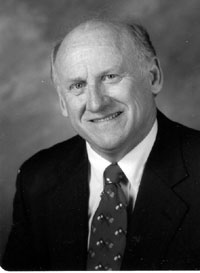
As a tribute to this noted newspaper editor and publisher, I’m going to illustrate some of the forms of wordplay he (and I) enjoyed. The pun, with the technical name paronomasia, is a form of word play that exploits multiple meanings of a term, or of similar-sounding words, for a humorous effect. The pun has also been defined as a “conceit arising from the use of two words that agree in the sound, but differ in the sense.” Here’s a simple example: “Energizer Bunny Arrested! Charged with Battery.” Like most puns that one is more likely to evoke a smile than a laugh.
Here’s a better example: Sherman has a Thai restaurant that I frequent, and if I were there with three friends, each of whom ordered a curry, I would be tempted to say, “Hey, let’s not get curried away here!”
Puns are considered the weakest form of humor because they are short-lived: whatever comic effect they possess rarely outlasts the split second it takes to sort out the semantic confusion. Even the best puns might be judged as clever, perhaps, but hardly the occasion for knee-slapping laughter.
Since the pun is regarded as an inferior species of humor, many high-brow authors studiously avoid it. But not William Shakespeare, who is estimated to have used over 3,000 puns in his plays. Here is an example from Richard III: “Now is the winter of our discontent made glorious summer by this son [sun] of York.
Another interesting form of wordplay that depends on misuse of language is the malapropism. It differs from the pun in that it’s an erroneous variation on a correct expression. The word comes from a character named "Mrs. Malaprop" in Richard Sheridan's 1775 play The Rivals. Mrs. Malaprop frequently misspeaks (to comic effect) by using words that don't have the meaning she intends but sound similar to words that do. She says "illiterate him quite from your memory" (instead of "obliterate"), and goes on to state of another character "she's as headstrong as an allegory on the banks of the Nile" (instead of alligator).
Sheridan chose her name as a humorous reference to the word malapropos, derived from the French phrase that means literally "poorly placed.”
Although Sheridan gave us the word, he did not invent malapropisms. Shakespeare used them for comic effects in a number of his plays. In Much Ado About Nothing, Constable Dogberry tells Governor Leonato, "Our watch, sir, have indeed comprehended two auspicious persons" (i.e., apprehended two suspicious persons).
Comedians often resort to malapropisms, and Stan Laurel used them well.
In the movie Sons of the Desert, for example, he says that Oliver Hardy is suffering a nervous "shakedown" (rather than "breakdown"); he then calls the Exalted Ruler of their group the "exhausted ruler" and says that he and Oliver are like "two peas in a pot" (meaning "pod").
As for Mr. Crawford’s interest in finding typographical errors in print, they have become so commonplace that I could easily write an entire column illustrating humorous ones. The once-important job of proofreading to catch and correct goofs seems to have been abandoned totally by today’s journalists.
Jerry Lincecum is a retired Austin College professor who now teaches classes for older adults who want to write their life stories. A new class begins at Grayson College on Sept. 4 as part of their Community Education program.